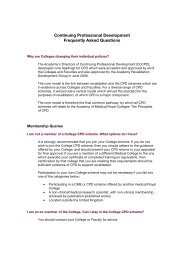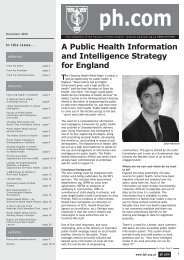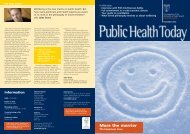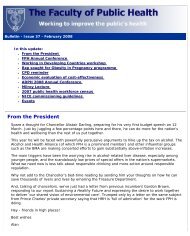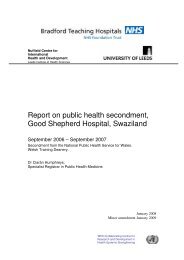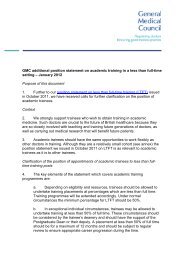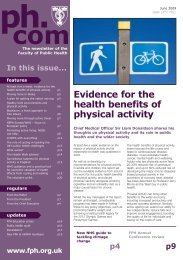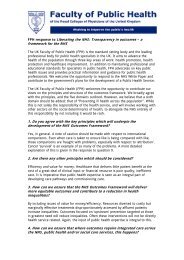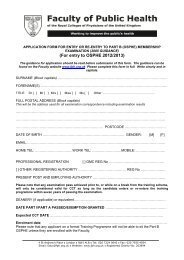A Chronology of State Medicine, Public Health, Welfare and Related ...
A Chronology of State Medicine, Public Health, Welfare and Related ...
A Chronology of State Medicine, Public Health, Welfare and Related ...
Create successful ePaper yourself
Turn your PDF publications into a flip-book with our unique Google optimized e-Paper software.
1972 Cont 1<br />
1972 cont Poisons Act (c.66) consolidated previous acts dealing with the list <strong>of</strong> poisons, the<br />
regulation <strong>of</strong> their sale <strong>and</strong> storage, <strong>and</strong> the constitution <strong>of</strong> the Poisons Board.<br />
Deposit <strong>of</strong> Poisonous Waste Act (c.21) prohibited the deposition <strong>of</strong> certain wastes<br />
without the knowledge <strong>of</strong> local authorities <strong>and</strong> water boards. See 1974.<br />
School leaving age raised to 16 years from September.<br />
"Framework for Government Research <strong>and</strong> Development", Cmnd.5046, set out the<br />
Government's acceptance <strong>of</strong> many <strong>of</strong> Lord Rothschild's recommendations (1971); gave<br />
details <strong>of</strong> the transfer <strong>of</strong> funds from the research councils to the customer departments;<br />
announced its intention to reconstitute the Council for Scientific Policy; <strong>and</strong> to appoint a<br />
chief scientist to the Department <strong>of</strong> <strong>Health</strong> <strong>and</strong> Social Security. Later RHL Cohen was<br />
appointed to this post. See 1978.<br />
The Committee (chairman, MA Bains) set up by the Department <strong>of</strong> the Environment in<br />
its report, "The New Local Authorities: Management <strong>and</strong> Structure", criticised the ingrained<br />
departmental approach "whereby each major department was very much a law unto itself<br />
reporting to its relevant committee"; <strong>and</strong> recommended a corporate approach to management<br />
with the appointment <strong>of</strong> a chief executive; the creation <strong>of</strong> a central management committee;<br />
reduction in the number <strong>of</strong> committees; <strong>and</strong> the removal <strong>of</strong> the protected status <strong>of</strong> certain<br />
<strong>of</strong>ficers. Similar recommendations were made in Scotl<strong>and</strong> (see 1973).<br />
"National <strong>Health</strong> Service Reorganisation: Engl<strong>and</strong>" (White Paper), Cmnd.5055, added<br />
some details to the outline proposals in the 1971 consultative document. The paper set out the<br />
structure, functions, membership <strong>and</strong> <strong>of</strong>ficers <strong>of</strong> the regional <strong>and</strong> area health authorities, <strong>and</strong><br />
<strong>of</strong> the family practitioner committees; the Boards <strong>of</strong> Governors <strong>of</strong> the undergraduate teaching<br />
hospitals to be abolished <strong>and</strong> the hospitals to be managed within the area <strong>and</strong> regional<br />
structure; <strong>and</strong> community health councils to be set up at district level. Environmental health,<br />
personal social services <strong>and</strong> aspects <strong>of</strong> health education to remain with local government, but<br />
the other previous duties <strong>of</strong> the departments <strong>of</strong> medical <strong>of</strong>ficers <strong>of</strong> health, including school<br />
health services, to be transferred to the NHS. Responsibility for the health <strong>of</strong> persons in<br />
relation to their employment to remain with the Department <strong>of</strong> Employment. The White<br />
Paper stated that the new specialists in community medicine would be concerned with<br />
"assessing need for health services, evaluating the effectiveness <strong>of</strong> existing services <strong>and</strong><br />
planning the best use <strong>of</strong> health resources. Equally, they will concern themselves with<br />
developing preventive health services, with the links between the health <strong>and</strong> the local<br />
authority personal social, environmental health <strong>and</strong> education services, <strong>and</strong> with providing<br />
the medical advice <strong>and</strong> help which local authorities will need for the administration <strong>of</strong> those<br />
<strong>and</strong> other services". See 1973.<br />
"National <strong>Health</strong> Service Reorganisation in Wales", Cmnd.5057, proposed eight area<br />
health boards responsible directly to the Secretary <strong>of</strong> <strong>State</strong> for Wales, <strong>and</strong> the establishment<br />
<strong>of</strong> the Welsh Technical Services Organisation.<br />
Women Doctors Retainer Scheme introduced into the NHS to enable doctors who<br />
could only work occasional sessions to continue involvement in medical practice.<br />
The Staff Advisory Committee, which in 1973 became the NHS Staff Commission,<br />
was set up to organise <strong>and</strong> supervise the appointments <strong>and</strong> transfers <strong>of</strong> staff from the old to<br />
the new authorities. See 1975.<br />
The Steering Committee on Management Arrangements for the Reorganised National<br />
<strong>Health</strong> Service (chairman, Sir Philip Rogers) set out the management structure <strong>and</strong> job<br />
descriptions <strong>of</strong> the senior <strong>of</strong>ficers in considerable detail. Each health district was to have a<br />
district management team composed <strong>of</strong> the administrator, the secretary, the community



